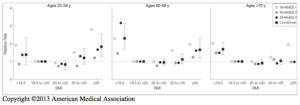Research that Changed Research: Who will live longest: Underweight, Overweight, or Obese?
The prevalence of obesity and its association with health issues has been a growing concern in the United States. Many people are aware that obesity and overweight increases the risk of cardiovascular diseases and disabilities. However, is the hype about obesity distracting us from health outcomes at other BMI levels?
Katherine M. Flegal, Ph.D, and her colleagues looked further into the association of body weight and excess mortality through reports from the National Health and Nutrition Examination Survey (NHANES) conducted by the National Center for Health Statistics. By using baseline data from past surveys, researchers were able to estimate the deaths of U.S. individuals who are classified as underweight, overweight, and obese according to their Body Mass Index (BMI) levels. Body mass index was calculated as weight in kilograms divided by the square of height in meters. The BMI categories are as follows: underweight (BMI <18.5), overweight (BMI 25 to <30), and obesity (BMI ≥30).
The table below shows the risk of mortality at each BMI level broken down by age groups.
Dr. Flegal found that underweight and obesity increase the likelihood of mortality compared to those with normal BMI levels. However, improvements in medical care and cardiovascular treatment has led to a decrease in morality rates of obese individuals. These results are consistent with the increase in life expectancy in the United States. The passage below is from the original article:
“We did not find overweight (BMI 25 to <30) to be associated with increased mortality in any of the 3 surveys. Our results are similar to those of a previous analysis of NHANES I and II data that found little effect of overweight on life expectancy… In many studies, a plot of the relative risk of mortality against BMI follows a U-shaped curve, with the minimum mortality close to a BMI of 25; mortality increases both as BMI increases above 25 and as BMI decreases below 25, which may explain why risks in the overweight category are not much different from those in the normal weight category.”
The results from this study demonstrates the importance of maintaining a healthy weight. It is also important to note that not only is there an increase in excess mortality for obesity, but also for underweight. And the most ground-breaking part of this study is that it seems that the lowest mortality risk falls somewhere between overweight and OBESE! Dr. Flegal’s research findings have inspired the DiSH Lab to reconsider BMI as a reliable marker of someone’s health – according to this study, it just isn’t.




